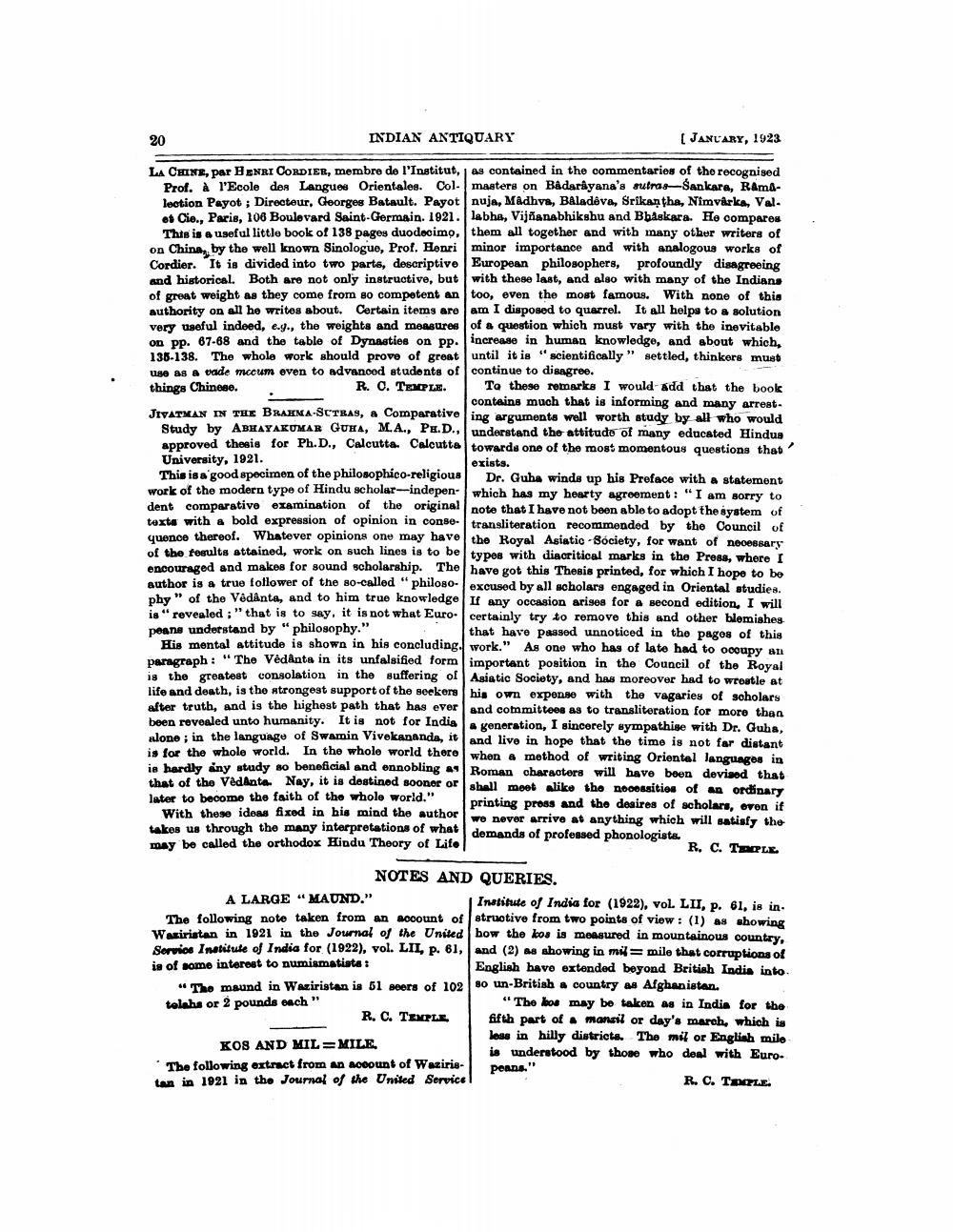________________
20
INDIAN ANTIQUARY
LA CHINE, par HENRI CORDIER, membre de l'Institut, Prof. à l'Ecole des Langues Orientales. Collection Payot ; Directeur, Georges Batault. Payot et Cie., Paris, 106 Boulevard Saint-Germain. 1921. This is a useful little book of 138 pages duodecimo, on Chine, by the well known Sinologue, Prof. Henri Cordier. It is divided into two parts, descriptive and historical. Both are not only instructive, but of great weight as they come from so competent an authority on all he writes about. Certain items are very useful indeed, e.g., the weights and measures on pp. 67-68 and the table of Dynasties on pp. 135-138. The whole work should prove of great use as a vade mccum even to advanced students of things Chinese. R. C. TEMPLE.
JIVATMAN IN THE BRAHMA-SUTRAS, a Comparative Study by ABHAYAKUMAR GUHA, M.A., PH.D., approved thesis for Ph.D., Calcutta. Calcutta University, 1921.
This is a good specimen of the philosophico-religious work of the modern type of Hindu scholar-independent comparative examination of the original texts with a bold expression of opinion in consequence thereof. Whatever opinions one may have of the results attained, work on such lines is to be encouraged and makes for sound scholarship. The author is a true follower of the so-called "philosophy" of the Vêdânta, and to him true knowledge is" revealed;" that is to say, it is not what Europeans understand by "philosophy."
His mental attitude is shown in his concluding paragraph: "The Vedanta in its unfalsified form is the greatest consolation in the suffering of life and death, is the strongest support of the seekers after truth, and is the highest path that has ever been revealed unto humanity. It is not for India alone; in the language of Swamin Vivekananda, it is for the whole world. In the whole world there is hardly any study so beneficial and ennobling a that of the Vedanta. Nay, it is destined sooner or later to become the faith of the whole world."
With these ideas fixed in his mind the author takes us through the many interpretations of what may be called the orthodox Hindu Theory of Life
[ JANUARY, 1923
as contained in the commentaries of the recognised masters on Bâdarayana's sutras-Sankara, Ramanuja, Madhva, Baladeva, Srikantha, Nimvarka, Vallabha, Vijñanabhikshu and Bhaskara. He compares them all together and with many other writers of minor importance and with analogous works of European philosophers, profoundly disagreeing with these last, and also with many of the Indians too, even the most famous. With none of this am I disposed to quarrel. It all helps to a solution of a question which must vary with the inevitable increase in human knowledge, and about which, until it is "scientifically" settled, thinkers must continue to disagree.
A LARGE "MAUND."
The following note taken from an account of Waziristan in 1921 in the Journal of the United Service Institute of India for (1922), vol. LII, p. 61, is of some interest to numismatists:
To these remarks I would add that the book contains much that is informing and many arresting arguments well worth study by all who would understand the attitude of many educated Hindus towards one of the most momentous questions that
exists.
Dr. Guha winds up his Preface with a statement which has my hearty agreement: "I am sorry to note that I have not been able to adopt the system of transliteration recommended by the Council of the Royal Asiatic Society, for want of necessary types with diacritical marks in the Press, where I have got this Thesis printed, for which I hope to be excused by all scholars engaged in Oriental studies. If any occasion arises for a second edition, I will certainly try to remove this and other blemishes that have passed unnoticed in the pages of this work." As one who has of late had to occupy an important position in the Council of the Royal Asiatic Society, and has moreover had to wrestle at his own expense with the vagaries of scholars and committees as to transliteration for more than a generation, I sincerely sympathise with Dr. Guha, and live in hope that the time is not far distant when a method of writing Oriental languages in Roman characters will have been devised that shall meet alike the necessities of an ordinary we never arrive at anything which will satisfy the printing press and the desires of scholars, even if demands of professed phonologists.
R. C. TEMPLE.
NOTES AND QUERIES.
Institute of India for (1922), vol. LII, p. 61, is instructive from two points of view: (1) as showing how the kos is measured in mountainous country, and (2) as showing in mil mile that corruptions of English have extended beyond British India into.
"The maund in Waziristan is 51 seers of 102 so un-British a country as Afghanistan. telahs or 2 pounds each"
R. C. TEMPLE. KOS AND MIL= MILE
The following extract from an account of Waziristan in 1921 in the Journal of the United Service!
"The kos may be taken as in India for the fifth part of a manzil or day's march, which is less in hilly districts. The mil or English mile is understood by those who deal with Europeans."
R. C. TEMPLE.




